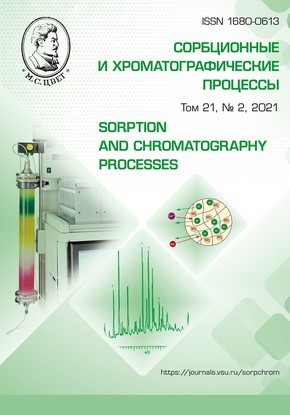Synthesis and application of magnetic molecularly imprinted with tetracycline polymer nanoparticles in a piezoelectric sensor
Abstract
The aim of the study was the synthesis of magnetic molecularly imprinted with tetracycline polymer nanoparticles (Fe3O4@ MIP) by the core-shell by grafting method and assessing the possibility of their application as recognition components of a piezoelectric sensor.
In the course of the study, the conditions for the synthesis of magnetic polymers with molecular imprints of tetracycline by the "core-shell" method were established. Molecular imprinted polymers (MIP) synthesized by the core-shell method have already proven themselves as selective sorbents for the concentration and separation of various organic compounds. In this case, firstly, the spherical shape of the core is achieved and the degree of dispersion of the synthesized particles Fе3O4@MIP with a uniform surface morphology increases, and secondly, molecular imprints are concentrated in a rather thin layer, which speeds up re-binding to the template. Magnetic cores were obtained by a modified coprecipitation method, then their surface was hydrophobized with oleic acid to facilitate fixation of the polymer layer, and then a molecularly imprinted polymer "shell" was synthesized by free radical polymerization using methacrylic acid and ethylene glycol dimethocrylate.
By studying the turbidity spectrum, the average radii of magnetic nuclei Fе3O4(65±3 nm), magnetic particles Fе3O4r@ PMO (93±4 nm) and Fе3O4@ NIP (127±6 nm) and the estimated thickness of the surface polymer layer for Fе3O4@ MIP (28±5 nm) and Fе3O4@ NIP (62±8 nm). The results obtained correlated with the sizes of nanoparticles determined by the AFM method. The conditions for the formation of a recognition layer based on Fе3O4@MIP particles on the surface of a gold electrode of a piezoelectric sensor under the influence of a magnetic field generated by a neodymium magnet were studied. The method of piezoelectric microweighting was used for the estimation of the surface concentration of molecular imprints and the stability of the recognition layer based on magnetic Fe3O4@MIP tetracycline particles. The metrological characteristics of a piezoelectric sensor for the determination of tetracycline have been established: the equation of the calibration function has been obtained, the range of the determined antibiotic contents has been determined (16-275 μg/ml), and the detection limit has been calculated (4.5 μg/ml). Parameters of a piezoelectric sensor based on magnetic Fе3O4@MIP particles indicate the possibility of its use for the detection and determination of tetracycline in liquid media.
Downloads
References
Gupta N., Pant P., Gupta C., Goel P., Jain A. et al., Materials Research Innova-tions, 201, Vol. 22, pp. 434-450.
Ahmadi M., Elmongy H., Madrakian T., Abdel-Rehim M., Analytica Chimica Acta, 2017, Vol. 959, pp. 1-21.
Gubin S.P., Koksharov YU.A., KHo-mutov G.B., YUrkov G.Yu., Uspekhi khimii, 2005, Vol. 74, pp. 539-574.
Tolmacheva V.V., Apyari V.V., Kochuk E.V., Dmitrienko S.G., Zhurn. analit. Khimii, 2016, Vol. 71, No 4, pp. 339-356.
Chahkandi M., Amiri A., Roghayyeh S., Arami S., Microchem. Journal, 2019, Vol. 144, pp. 261-269.
Ma W.-F., Zhang Y., Li L.-L., You L.-J. et al., ACS Nano, 2012, Vol. 6, pp. 3179-3188.
Ma W.-F., Zhang C., Zhang Y.-T., Yu M. et al., Langmuir, 2014, Vol. 30, pp. 6602-6611.
Janoš P., Kormunda M., Životský O., Pilařová V., Sep. Sci. Technol., 2013, Vol. 48, pp. 2028-2035.
Tahmasebi E., Yamini Y., Mehdinia A., Rouhi F., J. Sep. Sci., 2012, Vol. 35, pp. 2256-2265.
Shahrebabak S.M., Saber-Tehrani M., Faraji M., Shabanian M., Aberoomand-Azar P., Environ Monit Assess, 2020, Vol. 192, pp. 262-272.
Samadishadlou M., Farshbaf M., Anna-bi N., Kavetskyy T. et al., Artificial Cells, Nanomedicine and Biotechnology, 2018, Vol. 46, No 7, pp. 1314-1330.
Korneva G., Ye H., Gogotsi Y., Nano Letters, 2005, Vol. 5, pp. 879-884.
Grazhulene S.S., Zolotareva N.I., Red'kin A.N., SHilkina N.N. et al., Zh. prikl. Khimii, 2018, Vol. 91, No 11, pp. 1642-1649.
Oh J.K., Park J.M., Prog. Polym. Sci., 2011, Vol. 36, pp. 168-189.
Yang C., Wu J., Hou Y., Chem. Com-mun., 2011, Vol. 47, pp. 5130-5141.
Kubrakova I.V., Koshcheeva I.Ya., Pryazhnikov D.V., Martynov L.YU. et al., ZHurn. analit. Khimii, 2014, Vol. 69, No 4, pp. 378-389.
Liu T., Xie J., Zhao J., Song G., Hu Y., Food Anal. Methods, 2014, Vol. 7, pp. 814-819.
Yan H., Cheng X., Sun N., Journal of Agricultural and Food Chemistry, 2013, Vol. 61, pp. 2896-2901.
Changa L., Chena S., Li X., Applied Surface Science, 2012, Vol. 258, pp. 6660-6664.
Chen L., Li B., Food Chem., 2013,. Vol. 141. pp. 23-28.
Kong X., Gao R., He X., Chen L. et al., J. Chromatogr. A, 2012, Vol. 1245, pp. 8-16.
Turiel E., Díaz‐Álvarez M., Martín‐Esteban A., Separation Science, 2020, Vol. 43, Is. 16, pp. 3304-3314.
Rocha-Santos T.A.P., Trend. Anal. Chem., 2014, Vol. 62, pp. 28-36.
Ermolaeva T.N., Farafonova O.V., Bes-sonov O.I., Sorbtsionnye i khromatografich-eskie protsessy, 2019, Vol. 19, No 6, pp. 682-690.
Ermolaeva T.N., Farafonova O.V., CHernyshova V.N., Zyablov A.N. et al., ZHurn. analit. Khimii, 2020, Vol. 75, No 10, pp. 898-906.
Karaseva N, Ermolaeva T, Mizaikoff B., Sensors and actuators B: Chemical, 2018, Vol. 225, pp. 199-208.
Sauerbrey G.Z., Phys. Chem., 1959, Vol. 155, pp. 206-222.
Chen H., Zhang Y., Gao B., Xu Y. et al., Environ. Sci. Pollut. Res., 2013, Vol. 20, pp. 8567-8578.
Ermolaeva T.N., Farafonova O.V. Pa-tent na izobretenie RU 2687742 C1. 16.05.2019. Zayavka № 2017147140 ot 29.12.2017.







